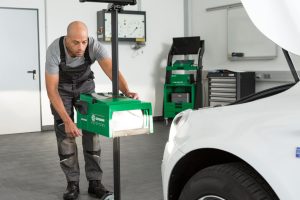Headlights are one of the most critical safety features on any vehicle. They ensure visibility during night driving, fog, or poor weather — and also help oncoming drivers see you clearly. However, even the most advanced lighting system is only effective when it’s properly aligned and aimed. Incorrectly adjusted headlights can blind other drivers, reduce your own visibility, and even lead to accidents.
In this article, we’ll explain why headlight alignment matters, how to check and adjust your headlights at home, and what tools and guidelines you should follow to ensure maximum road safety.
Why Proper Headlight Alignment Matters

Headlight misalignment can occur for several reasons — rough roads, minor collisions, suspension wear, or even replacing bulbs or headlight assemblies. When the beams are aimed too high, they dazzle oncoming traffic; when too low, they limit your visibility.
Key reasons to maintain correct alignment:
-
Improved visibility: Properly aimed lights illuminate the road evenly without creating dark spots.
-
Increased safety: You see obstacles, pedestrians, and road signs earlier.
-
Reduced glare: Prevents temporary blindness for oncoming drivers.
-
Compliance with regulations: Many countries require periodic headlight inspections.
-
Longer component life: Correct aim reduces strain on bulbs and housing from heat or vibration.
Signs Your Headlights May Be Misaligned
If you experience any of the following, it’s time to inspect your headlight aim:
-
One side of the road appears brighter than the other.
-
Oncoming drivers flash their lights at you frequently.
-
Your light beams seem to “cut off” too close to the vehicle.
-
Poor illumination during turns or while driving uphill/downhill.
-
You replaced bulbs, suspension parts, or the headlight housing recently.
Tools and Materials Needed
Before starting, gather these simple tools:
-
Flat, level surface and a flat wall or garage door.
-
Measuring tape (at least 5 meters long).
-
Masking tape.
-
Screwdriver or wrench (depending on headlight adjuster type).
-
Owner’s manual for vehicle-specific adjustment details.
Optional:
-
Headlight aiming gauge (for professional accuracy).
-
Helper or friend for easier measurements.
Preparation: Setting Up for Accurate Adjustment
Proper setup ensures reliable results. Follow these preparatory steps:
-
Check tire pressure – Uneven pressure can tilt your vehicle.
-
Remove excess weight – Keep only the driver’s weight and about half a tank of fuel.
-
Ensure the vehicle is on a level surface – No slope or incline.
-
Clean headlight lenses – Dirt or fogging can distort beam pattern.
-
Bounce the car gently – Let the suspension settle naturally.
Step-by-Step Guide to Aligning Your Headlights
You can easily adjust your headlights at home in about 30–45 minutes.
Step 1: Park and Measure
-
Park your car 3–5 meters from a flat wall or garage door.
-
Turn on low beams.
-
Use masking tape to mark the horizontal centerline of each light beam on the wall.
-
Mark a vertical line through the center of each beam — these will be your alignment reference points.
Step 2: Reverse and Observe
Move the car back about 7.5 meters (25 feet). The beam pattern should drop slightly but stay centered horizontally.
Step 3: Locate Adjustment Screws
Most vehicles have two adjusters per headlight:
-
Vertical screw: adjusts up or down.
-
Horizontal screw: adjusts left or right.
Check your owner’s manual to locate them precisely.
Step 4: Adjust the Vertical Aim
-
Rotate the vertical adjuster so the top of the most intense part of the beam is slightly below the horizontal line you marked.
-
This prevents glare for oncoming traffic.
Step 5: Adjust the Horizontal Aim
-
Adjust the horizontal screw so the most intense part of the beam sits slightly to the right of the vertical line (for right-hand traffic countries).
-
This ensures optimal illumination of the roadside without blinding other drivers.
Step 6: Recheck and Test Drive
After adjusting, test your lights on a dark road. Make sure:
-
The beam pattern is symmetrical.
-
The right beam lights up the roadside adequately.
-
You’re not blinding oncoming vehicles.
Headlight Alignment Reference Table
| Parameter | Ideal Position | Common Issue if Incorrect |
|---|---|---|
| Vertical Aim | Beam top 5–10 cm below centerline at 7.5 m distance | Too high → glare, Too low → short visibility |
| Horizontal Aim | Beam slightly right of centerline | Too far right → poor lane coverage, Too far left → glare |
| Beam Cutoff Shape | Sharp, flat upper edge | Fuzzy or scattered light pattern |
| Beam Distance (low beam) | 45–60 m visibility | Short range if too low |
| Beam Distance (high beam) | 90–120 m visibility | Causes glare if misaligned |
Special Considerations for LED and HID Headlights
Modern vehicles often use LED or HID (xenon) lights instead of traditional halogen bulbs. These systems produce brighter, whiter light but are more sensitive to misalignment.
Tips for these types:
-
Avoid touching or adjusting internal projector components.
-
Use built-in electronic leveling if available.
-
Ensure all mounting brackets are correctly positioned after bulb replacement.
-
Check local regulations — some countries require headlight leveling systems with HID units.
When to Seek Professional Help
While DIY alignment works for minor corrections, professional adjustment is recommended if:
-
Your car uses adaptive headlights (auto-leveling or cornering).
-
The light pattern seems irregular or scattered.
-
You’ve replaced suspension parts or experienced a front-end impact.
-
You can’t identify the correct adjustment screws.
Workshops use optical alignment systems or laser alignment tools that ensure precise calibration according to manufacturer standards.
Maintenance Tips for Long-Lasting Headlight Performance

To maintain perfect illumination, follow these maintenance tips:
-
Clean lenses regularly – Dirt and oxidation reduce brightness.
-
Replace bulbs in pairs – Uneven brightness affects visibility.
-
Check headlight alignment every 12 months – Especially after suspension or tire changes.
-
Inspect housing seals – Moisture inside headlights can distort the beam.
-
Use OEM or certified replacement parts – Inferior lenses or reflectors distort light projection.
For reliable and high-quality components, you can Buy Car Lighting online — including bulbs, housings, and LED upgrades suited for your vehicle.
Common Headlight Alignment Mistakes
| Mistake | Effect | Prevention |
|---|---|---|
| Adjusting on uneven ground | Misaligned beams | Use a flat, level surface |
| Incorrect tire pressure | Tilted aim | Check tires before adjustment |
| Ignoring load balance | Wrong vertical height | Keep car half-fueled, driver only |
| Adjusting with dirty lenses | Beam distortion | Clean headlights first |
| Over-tightening adjusters | Damage to assembly | Turn screws gently |
Conclusion
Proper headlight alignment is more than a technical detail — it’s a safety necessity. Correctly aimed lights help you see the road clearly without dazzling others, reducing accident risks and improving night-time comfort.
By following these steps, checking your setup regularly, and using quality lighting components, you’ll ensure maximum performance and safety in every driving condition.
Whether you’re upgrading your system or replacing worn components, always choose trusted products. Visit Buy Car Lighting online to find headlights, bulbs, and accessories that guarantee clear, safe, and efficient illumination for your vehicle.